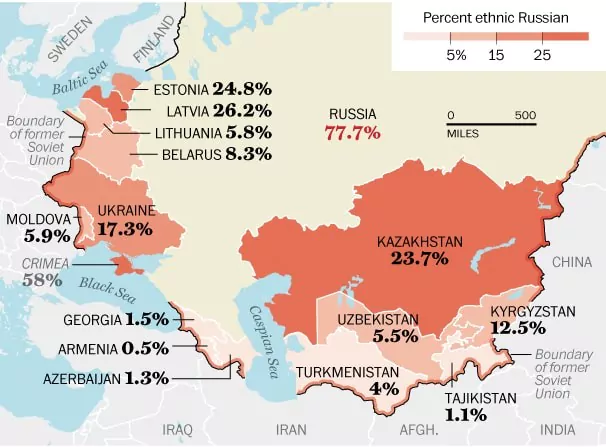 | ||
Countries | ||
Post soviet states
The post-Soviet states, also collectively known as the former Soviet Union (FSU) or former Soviet Republics, are the 15 independent states that emerged from the Union of Soviet Socialist Republics in its dissolution in December 1991, with Russia internationally recognised as the successor state to the Soviet Union. On March 11, 1990, Lithuania was the first to declare its independence, with Estonia and Latvia following suit in August 1991. All three Baltic states claimed continuity from the original states that existed prior to their annexation by the Soviet Union in 1944 and were admitted to the United Nations on 17 September 1991. The remaining 12 republics all subsequently seceded. 12 of the 15 states, excluding the Baltic states, initially formed the CIS and most joined CSTO, while the Baltic states focused on European Union and NATO membership.
Contents
- Post soviet states
- Transition russia post soviet states after the soviet era
- States and geographical groupings
- General statistics
- Economy
- Developmental progress
- Regional organizations
- Commonwealth of Independent States
- Eurasian Economic Community
- Customs Union of Belarus Kazakhstan and Russia
- Eurasian Economic Union
- Collective Security Treaty Organization
- North Atlantic Treaty Organization
- GUAM
- Union of Russia and Belarus
- Economic Cooperation Organization
- Community for Democracy and Rights of Nations
- Community of Democratic Choice
- Shanghai Cooperation Organisation
- For economic cooperation
- For political integration and security alliances
- In other domains
- Other
- Politics
- Separatist conflicts
- Current declared states
- Former declared states
- Civil wars
- Colour revolutions
- Russian population in post Soviet states
- Religion
- Post Soviet nostalgia
- References
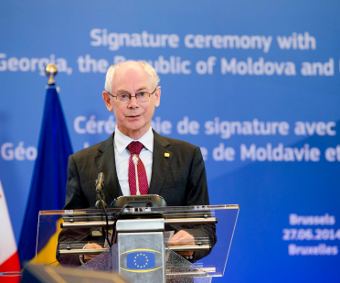
Transition russia post soviet states after the soviet era
States and geographical groupings
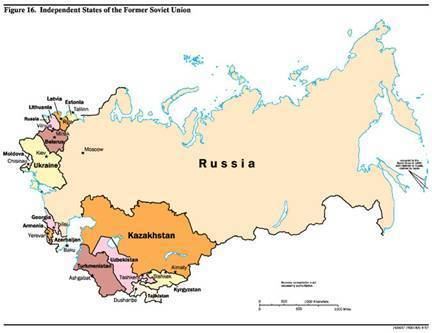
The 15 post-Soviet states are typically divided into the following five groupings. Each of these regions has its own common set of traits, owing not only to geographic and cultural factors but also to that region's history in relation to Russia. In addition, there are a number of de facto independent, but internationally unrecognized states (see the section Separatist conflicts below).
General statistics
Area includes land and water.
Economy
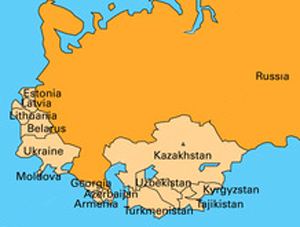
The dissolution of the Soviet Union took place as a result and against the backdrop of general economic stagnation, even regression. As the Gosplan, which had set up production chains to cross SSR lines, broke down, the inter-republic economic connections were also disrupted, leading to even more serious breakdown of the post-Soviet economies.
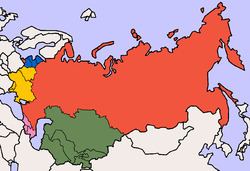
Most of the formerly Soviet states began the transition to a market economy from a command economy in 1990-1991 and made efforts to rebuild and restructure their economic systems, with varying results. In all, the process triggered severe economic declines, with Gross Domestic Product (GDP) dropping by more than 40% overall between 1990 and 1995. This decline in GDP was much more intense than the 27% decline that the United States suffered in the wake of the Great Depression between 1930 and 1934. The reconfiguration of public finance in compliance with capitalist principles resulted in dramatically reduced spending on health, education and other social programs, leading to a sharp increase in poverty. The economic shocks associated with wholesale privatization resulted in the deaths of roughly 1 million working age individuals throughout the former Soviet bloc in the 1990s.
The initial transition decline was eventually arrested by the cumulative effect of market reforms, and after 1995 the economy in the post-Soviet states began to recover, with GDP switching from negative to positive growth rates. By 2007, 10 of the 15 post-Soviet states had recovered and reached GDP greater than what they had in 1991. Only Moldova, Ukraine, Georgia, Kyrgyzstan, and Tajikistan had GDP significantly below the 1991 level. The recovery in Russia was marginal, with GDP in 2006-2007 just nudging above the 1991 level. Combined with the aftershocks of the 1998 economic crisis it led to a return of more interventionist economic policies by Vladimir Putin's administration.
Change in Gross Domestic Product (GDP) in constant prices, 1991-2015
*Economy of most Soviet republics started to decline in 1989-1990, thus indices for 1991 don't match pre-reform maximums.
**The year when GDP decline switched to GDP growth.
List of the present Gross domestic product (GDP) (figures are given in 2013 United States dollars for the year 2013 according to The World Factbook):
Developmental progress
The post-Soviet states listed according to their Human Development Index scores (2015).
Very High Human Development:
High Human Development:
Medium Human Development:
Regional organizations
A number of regional organizations and cooperating blocs have sprung up since the dissolution of the Soviet Union. Only organizations that are mainly (or completely) composed of post-Soviet states are listed in this section; organizations with wider memberships are not discussed. The 15 post-Soviet states are divided in their participation to the regional blocs:
Commonwealth of Independent States
The Commonwealth of Independent States (CIS) consists of 11 former Soviet Republics that differ in their membership status. As of December 2010, 9 countries have ratified the CIS charter and are full CIS members (Armenia, Azerbaijan, Belarus, Moldova, Kazakhstan, Kyrgyzstan, Russia, Tajikistan, Uzbekistan), one country (Turkmenistan) is an associate member, one country (Ukraine) is a founding and participating country, but legally not a member country, and one country (Georgia) left the organization in 2009. In 2014, Ukraine declined its CIS chairmanship and considered withdrawal from the organization.
In 1994, the CIS countries agreed to create a free trade area, but the agreements were never signed. On October 19, 2011 Armenia, Belarus, Kazakhstan, Kyrgyzstan, Moldova, Russia, Tajikistan, and Ukraine signed a free trade agreement. Uzbekistan joined the free trade area in 2013.
Eurasian Economic Community
The Eurasian Economic Community (EURASEC), formerly the CIS Customs Union, was established by Russia, Belarus, Kazakhstan, Kyrgyzstan and Tajikistan. Ukraine and Moldova have observer status in the community; however, Ukraine has declared its desire not to become a full member state. Because having common borders with the rest of the community is a prerequisite for full membership, Moldova is barred from seeking it. Uzbekistan applied for membership in October 2005, when the process of merging Central Asian Cooperation Organization and the Eurasian Economic Community began; it joined on 25 January 2006. Uzbekistan subsequently suspended its membership in 2008.
On 10 October 2014 an agreement on the termination of the Eurasian Economic Community was signed in Minsk after a session of the Interstate Council of the EAEC. The Eurasian Economic Community was terminated from 1 January 2015 in connection with the launch of the Eurasian Economic Union.
Customs Union of Belarus, Kazakhstan and Russia
Russia, Belarus, Kazakhstan created a customs union that entered into force in July 2010. Ukraine, Kyrgyzstan and Tajikistan indicated interest in joining at the time. Russia has been eager for Armenia, Moldova and Ukraine to join the custom union instead of the European Union, and the Moldovan break-away state of Transnitria has supported this. In 2013, Kyrgyzstan and Armenia announced plans to seek membership, but division over the issue in Ukraine led to the 2014 Ukrainian revolution after the Ukrainian government backed out of an EU Eastern Partnership in favor of the union. In 2014, voters in the Moldovan autonomous region of Gagauzia rejected closer ties to the EU in favor of the union.
On 1 January 2012, Russia, Kazakhstan and Belarus established the Single Economic Space which ensures the effective functioning of a single market for goods, services, capital and labour, and to establish coherent industrial, transport, energy and agricultural policies. The agreement included a roadmap for future integration and established the Eurasian Economic Commission (modelled on the European Commission). The Eurasian Economic Commission serves as the regulatory agency for the Eurasian Customs Union, the Single Economic Space and the Eurasian Economic Union.
Eurasian Economic Union
The Eurasian Economic Union is an economic union of post-Soviet states. The treaty aiming for the establishment of the EEU was signed on 29 May 2014 by the leaders of Belarus, Kazakhstan and Russia, and came into force on 1 January 2015. Treaties aiming for Armenia's and Kyrgyzstan's accession to the Eurasian Economic Union were signed on 9 October 2014 and 23 December respectively. Armenia's accession treaty came into force on 2 January 2015. Although Kyrgyzstan's accession treaty will not come into force until May 2015, provided it has been ratified, it will participate in the EEU from the day of its establishment as an acceding state. Moldova and Tajikistan are prospective members.
Collective Security Treaty Organization
Seven CIS member states, namely Russia, Belarus, Kazakhstan, Kyrgyzstan, Tajikistan, Uzbekistan and Armenia, have enhanced their military cooperation, establishing the Collective Security Treaty Organization (CSTO), this being an expansion of the previous Collective Security Treaty (CST). Uzbekistan which (alongside Georgia and Azerbaijan) withdrew from the CST in 1999, joined GUAM. Then in 2005 it withdrew from GUAM and joined the CSTO in 2006. On 28 June 2012, Uzbekistan suspended its membership in the CSTO.
North Atlantic Treaty Organization
Three former Soviet states are members of NATO: Estonia, Latvia and Lithuania. Georgia, where both public opinion and the ruling government favor NATO membership, is in the Intensified Dialogue program with NATO. In Ukraine after the 2010 electoral victory of Viktor Yanukovych, the government officially declared neutrality and no longer seeks NATO membership, as it did after the Orange revolution and the presidency of Viktor Yushchenko.
GUAM
Four member states, namely Georgia, Ukraine, Azerbaijan and Moldova established the GUAM group that was largely seen as intending to counter Russian dominance in the region. Notably, these four nations do not participate in any of the other regional organizations that sprang up in the region since the dissolution of the Soviet Union (other than the CIS).
Union of Russia and Belarus
The Union of Russia and Belarus was originally formed on 2 April 1996 under the name Commonwealth of Russia and Belarus, before being tightened further on 8 December 1999. It was initiated by the president of Belarus, Alexander Lukashenko. On paper, the Union of Russia and Belarus intends further integration, beyond the scope of mere cooperation, including the introduction of the ruble as a common currency.
Economic Cooperation Organization
The Economic Cooperation Organization was originally formed in 1985 by Turkey, Iran and Pakistan but in 1992 the organization was expanded to include Afghanistan and the six primarily Muslim former Soviet republics: Azerbaijan, Kazakhstan, Kyrgyzstan, Tajikistan, Turkmenistan and Uzbekistan.
Community for Democracy and Rights of Nations
The post-Soviet disputed states of Abkhazia, the Nagorno-Karabakh Republic, South Ossetia, and Transnistria are all members of the Community for Democracy and Rights of Nations which aims to forge closer integration.
Community of Democratic Choice
The Community of Democratic Choice (CDC) was formed in December 2005 at the primary instigation of Ukraine and Georgia, and composed of six post-Soviet states (Ukraine, Georgia, Moldova, and the three Baltic states of Estonia, Latvia and Lithuania) and three other countries of Eastern and Central Europe (Slovenia, Romania and the Republic of Macedonia). The Black Sea Forum (BSF) is a closely related organization. Observer countries include Armenia, Bulgaria, and Poland.
Just like GUAM before it, this forum is largely seen as intending to counteract Russian influence in the area. This is the only international forum centered in the post-Soviet space in which the Baltic states also participate. In addition, the other three post-Soviet states in it are all members of GUAM.
Shanghai Cooperation Organisation
The Shanghai Cooperation Organisation (SCO), is composed of China and five post-Soviet states, namely Russia, Kazakhstan, Kyrgyzstan, Tajikistan and Uzbekistan. The organization was founded in 2001, though its predecessor, the Shanghai Five grouping, has existed since 1996. Its aims revolve around security-related issues.
For economic cooperation
For political integration and security alliances
In other domains
Other
Apart from above, the former Soviet republics also hold membership in a number of multinational organizations such as:
Politics
Regarding political freedom in the former Soviet republics, Freedom House's 2015 report listed the following:
Similarly, the Worldwide Press Freedom Index published by Reporters Without Borders in 2015, recorded the following as regards press freedom:
It has been remarked that several post-Soviet states have not changed leadership since their independence, such as Nursultan Nazarbayev in Kazakhstan and Islam Karimov in Uzbekistan, until his death in September 2016. All of these had originally more limited terms but through decrees or referendums prolonged their stay in office (a practice also followed by Presidents Alexander Lukashenko of Belarus, Emomalii Rahmon of Tajikistan and Dmitry Medvedev of Russia.) Askar Akayev of Kyrgyzstan had likewise served as President since its independence until he was forced to resign as a result of the Kyrgyz revolution of 2005. Saparmurat Niyazov in Turkmenistan ruled from independence until his death in 2006, creating a personality cult around himself.
The issue of dynastical succession has been another element affecting the politics of some post-Soviet States. Heydar Aliyev, after constructing an extensive and ongoing cult of personality, handed the Presidency of Azerbaijan to his son, Ilham Aliyev. Theories about the children of other leaders in Central Asia being groomed for succession abound. The participation of Akayev's son and daughter in the 2005 Kyrgyz parliamentary elections boosted fears of dynastic succession being used in Kyrgyzstan as well, and may have contributed to the anti-Akayev climate that led to his overthrow.
Separatist conflicts
Economic, political, national, military, and social problems have all been factors in separatism in the Post-Soviet space. In many cases, problems due to factors such as ethnic divisions existed before the fall of the Soviet Union, and upon the fall of the union were brought into the open. Such territories and resulting military conflicts have so far been:
Current declared states
Former declared states
Civil wars
Civil wars unrelated to separatist movements have occurred twice in the region:
Colour revolutions
Since 2003, a number of (largely) peaceful "colour revolutions" have happened in some post-Soviet states after disputed elections, with popular protests bringing into power the former opposition.
Russian population in post-Soviet states
There is a significant Russophone population in most of the post-Soviet states, whose political position as an ethnic minority varies from country to country. While Belarus, Kazakhstan and Kyrgyzstan, in addition to Russia, have kept Russian as an official language, the language lost its status in other post-Soviet states after the end of the Soviet Union. It maintains semi-official status in all CIS member states, because it is the organisation's official working language, but in the three Baltic States, the Russian language is not recognized in any official capacity. Georgia, since its independence from the CIS in 2009, has begun operating its government almost exclusively in the Georgian language.
Religion
While the Soviet system placed severe restrictions on religious intellectual life, traditions continued to survive. After the dissolution of the Soviet Union, Islamic movements have emerged alongside ethnic and secular ones. Vitaly Naumkin gives the following assessment: "Throughout the time of change, Islam has served as a symbol of identity, a force for mobilization, and a pressure for democracy. This is one of the few social disasters that the church has survived, in which it was not the cause. But if successful politically, it faces economic challenges beyond its grasp."
The Central Asian states (Kazakhstan, Kyrgyzstan, Tajikistan, Turkmenistan, and Uzbekistan) plus Azerbaijan from Southern caucasus are Muslim, except for their dwindling Russian and other European minorities. The Baltic States are historically Western Christian (Protestant and Roman Catholic), which adds another layer of pro-Western orientation to those countries, although the vast majority of what was the Protestant population (Estonia and northern Latvia) there is now irreligious. The dominant religion in the remaining former Soviet countries (Armenia, Belarus, Georgia, Moldova, Russia, and Ukraine) is Orthodox Christianity. In most countries, religiosity has increased since the Soviet collapse.
Post-Soviet nostalgia
Ever since the dissolution of the Soviet Union a certain number of people have expressed a longing for the Soviet period and its values. The level of post-Soviet nostalgia varies across the former republics. For example, certain groups of people may blend the Soviet and post-Soviet experience in their daily lives..
According to July 2012 polling in Ukraine by RATING, 42% of respondents supported the formation of a unified state of Ukraine, Russia and Belarus; earlier in 2012 this support had been 48%.
A 2016 poll of Russian citizens conducted by Levada Center showed that the majority viewed the collapse of the USSR negatively and felt that it could have been avoided, and an even greater number would openly welcome a revival of the Soviet system.
